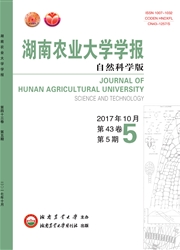

 中文摘要:
中文摘要:
以云南省育成的14个功能型水稻品种(系)为材料,在新平、玉溪和寻甸3个生态点种植,研究不同基因型粳稻的产量和功能成分含量及其生态变异。结果表明:寻甸的水稻平均产量、有效穗数和结实率均显著高于新平和玉溪,以新平最低,玉溪每穗穗粒数显著高于新平和寻甸,不同地区粳稻千粒重差异不显著;通径分析表明,限制新平、玉溪、寻甸水稻产量的主要因素分别为每穗粒数、有效穗数、结实率;基因型、环境及其互作均对产量及其构成因素和稻米功能成分有显著或极显著的影响,稻谷产量、有效穗数、每穗总粒数和结实率主要受生态环境的影响,而千粒重受基因型控制,γ–氨基丁酸受生态环境的影响,总黄酮、生物碱受基因型及基因型与环境互作的共同调节,抗性淀粉含量主要受基因型控制;新平水稻糙米γ–氨基丁酸和生物碱含量较高,玉溪和寻甸2种成分含量相接近;总黄酮以玉溪点最高,寻甸较低;不同地区抗性淀粉含量差异较小。
 英文摘要:
英文摘要:
Field experiments were conducted in Xinping,Yuxi and Xundian to investigate the yield and functional components and their environmental variation among different rice genotypes including 14 cultivars from Yunnan.The results showed that mean rice yield,valid spike number and seed setting rate in Xundian were significantly higher than those in Xinping and Yuxi,and those in Xinping were the lowest.Spikelets per panicle in Yuxi was significantly higher than that in Xinping and Xundian,while 1 000-grain weight showed no significant difference among three eco-sites.Path analysis showed that grain yield was mainly influenced by spikelets per panicle,valid panicles and seed setting rate.The grain yield and yield components and functional elements were significantly or very significantly affected by genotype(G),environment(E) and their interaction(G×E).The yield,valid panicles,spikelets per panicle and seed setting rate were mainly regulated by environment,while grain weight mainly by genotype.The γ-aminobutyric acid(GABA) was impacted by eco-environment,while total flavonoids and alkaloids by genotype and G×E interaction,and resistant starch(RS) by genotype.The GABA and alkaloids of brown rice were the highest in Xinping,and similar in Yuxi and Xundian.Total flavonoids were the highest in Yuxi,the lowest in Xundian.There was no significant difference in RS of brown rice among three eco-sites.
 同期刊论文项目
同期刊论文项目
 同项目期刊论文
同项目期刊论文
 期刊信息
期刊信息
